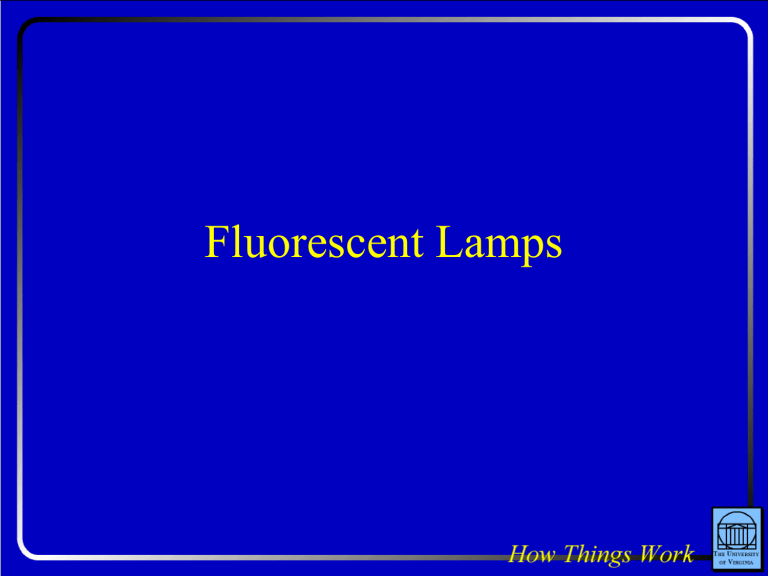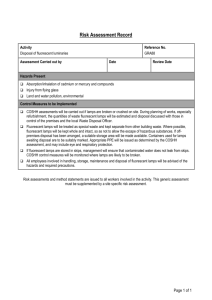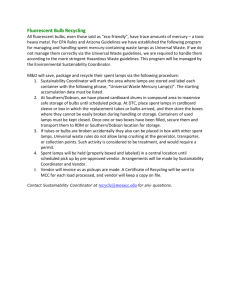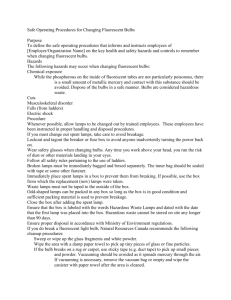Fluorescent Lamps

Fluorescent Lamps
Question:
A fluorescent lamp tube is coated with a white powder on its inside surface. If that powder were not there, would the lamp appear brighter, dimmer, or about the same overall brightness, but with an unpleasantly bright white line near its center?
Observations About Fluorescents
• They often take a few moments to turn on
• They come in several variations of white
• They are often whiter than incandescent bulbs
• They last longer than incandescent bulbs
• They sometimes hum loudly
• They flicker before they fail completely
Seeing in Color
• Three groups of light sensing cone cells
• We perceive different colors when two or more type of cone cells respond at once
Problems with Thermal Light
• Temperature too low, too red
– Incandescent light bulb, 2500°C
– The sun, 5800°C
• Not energy efficient
– Lots of invisible infrared light
– Only a small fraction of thermal power is visible
Fluorescent Lamps 1
• Glass tube, low pressure gas, electrodes
• Inject free charges via temperature or high voltage
• Forms a plasma—a gas of charged particles
• Electric field produces current flow in plasma
• Collisions cause
– electronic excitation in gas atoms
– some ionization of gas atoms
• Excited atoms emit light through fluorescence
Atomic Structure
• In an atom, the electrons orbit the nucleus
• Only certain orbits are allowed—the orbitals
• Each orbital can have at most two electrons in it
• Orbital’s energy = kinetic + potential
• Electrons normally reside in the lowest energy orbitals—the ground state
• Electrons can be excited to higher energy orbitals—excited states
Atomic Structure
• Electrons travel as waves
• Electron in an orbital doesn’t emit light
• Electron emits light when changing orbitals
Light from Atoms
• Light
– travels as a wave (a diffuse structure)
– is emitted or absorbed as a particle (a photon)
• Photon energy = Planck constant · frequency
• An atom’s orbitals have specific energy differences
• Energy differences establish photon energies
• An atom emits a specific spectrum of photons
Electron/Atom Collisions
• An electron bounces off an atom
– Electron loses no energy atom is unaffected
– Electron loses some energy atom becomes excited
– Electron loses lots of energy atom is ionized
Atomic Fluorescence
• Excited atoms lose energy via radiative transitions
• During transition, electrons shift to lower orbitals
• Photon energy is difference in orbital energies
– Small energy differences infrared photons
– Moderate energy differences red photons
– Big energy differences blue photons
– Very Big differences ultraviolet photons
• Atoms typically have bright “resonance lines”
• Mercury’s resonance line is at 254 nm, in the UV
Phosphors
• A mercury lamp emits mostly invisible UV light
• To convert its UV light to visible, use a phosphor
• Phosphors absorb photons and reemit new photons
• New photon energy is less than old photon energy
• Fluorescent lamps phosphors emit white light
– (Deluxe) warm white, (deluxe) cool white phosphors
• Specialty lamps phosphors emit colored light
– Blue, green, yellow, orange, red, violet, etc.
Question:
A fluorescent lamp tube is coated with a white powder on its inside surface. If that powder were not there, would the lamp appear brighter, dimmer, or about the same overall brightness, but with an unpleasantly bright white line near its center?
Fluorescent Lamps 2
• Starting discharge requires electrons
• Heated filaments can provide electrons
– Manual preheat lamps (initial filament heating)
– Automatic preheat lamps (initial filament heating)
– Rapid start lamps (constant filament heating)
– Only rapid start lamps can be dimmed
• High voltages can provide electrons
– Instant start lamps (high voltage pulse start)
Fluorescent Lamps 3
• Gas discharges are unstable
– Gas is initially insulating
– Once discharge is started, gas become a conductor
– The more current it carries, the better it conducts
– Current tends to skyrocket uncontrollably
• Stabilizing discharge requires ballast
– Inductor ballast (old, 60 Hz)
– Electronic ballast (new, high frequency)
Low-Pressure Discharge Lamps
• Mercury gas emits ultraviolet resonance light
– Low pressure mercury lamps emit ultraviolet light
• Some gases emit visible resonance light
• Low pressure sodium emits yellow-orange light
– Very energy efficient
– Extremely monochromatic and unpleasant
Pressure Broadening
• High pressures broaden each spectral line
– Collisions occur during photon emissions
– Frequency and wavelength become less sharply defined
– Collision energy compensates for photon energy
Radiation Trapping
• Radiation trapping occurs at high densities
– Atoms emit resonance radiation very efficiently
– Atoms also absorb resonance radiation very efficiently
– Resonance radiation photons are trapped in the gas
– Energy can only escape discharge via other transitions
High-Pressure Discharge Lamps
• At higher pressures, new spectral lines appear
• High-pressure sodium emits richer light spectrum
– Still fairly energy efficient
– Not so monochromatic, more pleasant illumination
• High-pressure mercury emits nearly white light
– A little too blue, but good efficiency and color
• Adding metal-halides improves whiteness
– Nearly true white and good efficiency






